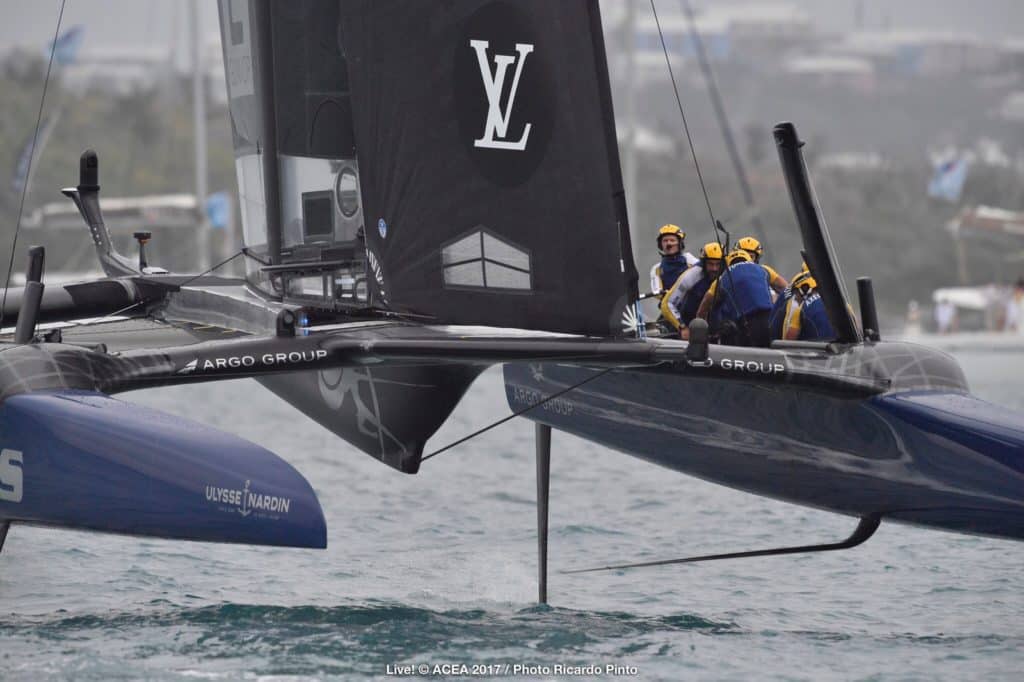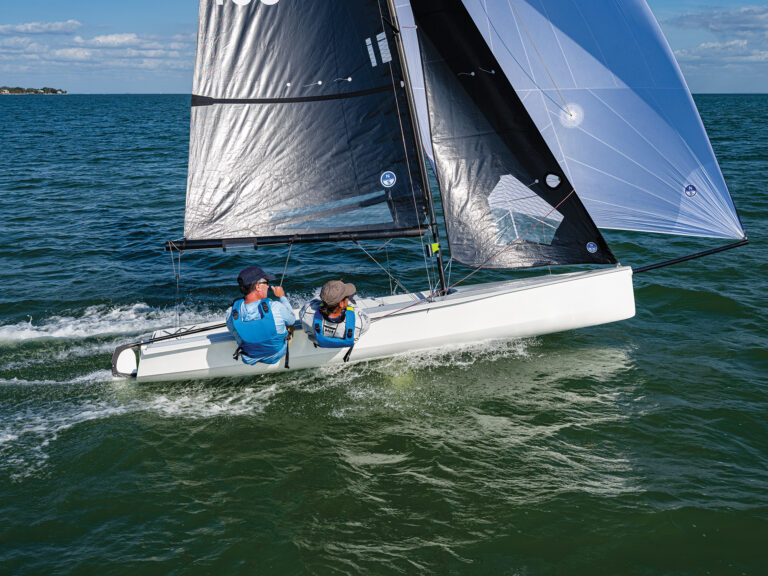
A stalled weather front sat to the west of the island of Bermuda on the morning of the Louis Vuitton America’s Cup Playoff Finals, threatening to suck most of the wind from Great Sound, and putting the first critical decision of the day firmly into the hands of the weather gurus of Artemis Racing Team and Emirates Team New Zealand. What was the breeze going to do and which foils would they pull from the quiver?
For Artemis, it was their light-air, high-lift foils, and for Emirates Team New Zealand, the “fast boards.” The Kiwis hedged that the forecast would trend upward as the afternoon wore on. They were right, and it would prove to be a key hedge in the outcome of the day.
Yes, Artemis Racing Team skipper would eventually miss his cockpit entry and take a dive into Great Sound at the most critical point in the third and final race of the day, but even then, the New Zealanders were split seconds away from gaining control of the match.
As the New Zealanders were inching ever closer to “having a piece” of Artemis, critical inches came thanks to foil choice. Artemis Racing were just outside the range of their light-air foils as the wind built to 14 knots. The Kiwis were only getting faster.

Both boats were getting to the top of Leg 5 with Artemis approaching the left boundary and Emirates Team New Zealand storming in from the right, the delta between them shrinking by the second.
Artemis tactician Ian Percy, felt he was still in position to control the race. Cue the winning move from yesterday when Artemis Racing tacked inside Softbank Team Japan, a move that sprung them into the Playoff Finals. “Same play as Japan,” said Percy before setting up for the tack. But this time it had to be a good one, they would do it better, with Percy staying to leeward to drop the board early, coast head to wind, and stop the race with a hard luff.
That was the plan, at least, and he was already two moves ahead, in his head.
“We would have been inside. It would have been all on,” he said.
Then came the countdown to the tack: 3…2…1…
The boat turned, Outteridge sprinted for his new cockpit, as he’s done thousands of times, went for his signature slide, but his left foot glanced the slick carbon cockpit coaming and there was no point of return.

I’ll be one for the highlight reels, for sure, and according to Bob Fisher, the dean and historian of this 166-year-old regatta, it is the first time an America’s Cup helmsman has gone overboard during a Cup race.
It was an unfortunate turn of events, one that effectively put a halt to a climactic top-mark meet up, and a chance for Artemis Racing to go one-up in the series. They’d won all three starts, sailed a perfect second race with 100-percent flight time, and were proving that despite the boats being different in many ways that they were evenly matched against the favored Kiwis.
They just had to control every race, which they’d done to perfection to this point (boundary penalty aside).
Grinder Christian Kamp summed it up best as they retired from the race: “It’s going to be a war gentleman, that was just a little battle and a little swim for our skipper.”
Emirates Team New Zealand skipper Peter Burling, however, had a different perspective of the potential top-mark engagement that never came to be. He’s confident they would have crossed.

“We thought we were going to have a pretty good shot at them at the top mark,” said Burling at the post-race press conference. “The boys were working super hard and we were still generating a serious amount of power so we could keep throwing it through some pretty good maneuvers and thought we’d have a piece of them at the top.”
As it turned out, they need that piece at the top, as Artemis gave it to them when Outteridge went for his swim.
Rewinding through the earlier races, Emirates Team New Zealand chose to enter Race 1 on starboard, which according to Chief Umpire Richard Slater has not, statistically, been a winning move. Port entry has one less maneuver. Regatta Director Iain Murray couldn’t offer any insight into the Kiwi’s selection and simply shrugged. “I don’t know why.”
An unconventional team with unconventional approaches to everything here in Bermuda.
Yet, start entry made no difference in the end as Artemis got the better of the Kiwis anyway, reaching off clean and ahead at 25 knots. Evenly matched as they paced down Leg 2, both boats sprinted into the left gate with the New Zealanders following.

The Swedes looked to be in firm control as they approached the left boundary soon after on Leg 3 and were set to tack out with rights. The boundary came quicker than they anticipated, however, and they dipped just outside the boundary, picking up a penalty and handing the race to the Kiwis. In a match with no margin for error, it was a big one, and the Kiwis simply sailed away with the gift in hand.
Artemis rebounded in Race 2, well in control at the start again, and all the way around the track to tie the series. Race 3 was looking like another one in the hands of Artemis, which led around Mark 1 with a comfortable margin and pulled ahead on the downwind leg, allowing a split at the first gate. As the speed readouts on the two boats started to reveal, however, the New Zealanders were getting consistently faster. New Zealand got one good shift to put them right into the hunt, and at the bottom of Leg 4, Artemis stumbled again with a bad jibe to the right-hand mark. They New Zealanders simply chipped away up Leg 5 until they were bow-to-bow.
Then, Outteridge went for a swim and it was over.
Tomorrow’s another day, and it’s supposed to be a light one, and Outteridge, still moist at the press conference, offered a silver lining: “We were surprised how well the boat performed up range [with the light-air foils]. Tomorrow we need to see if we can get some more pace out of those boards because in the first race we weren’t sailing very well, and looking at the forecast tomorrow, that’s our focus.”









